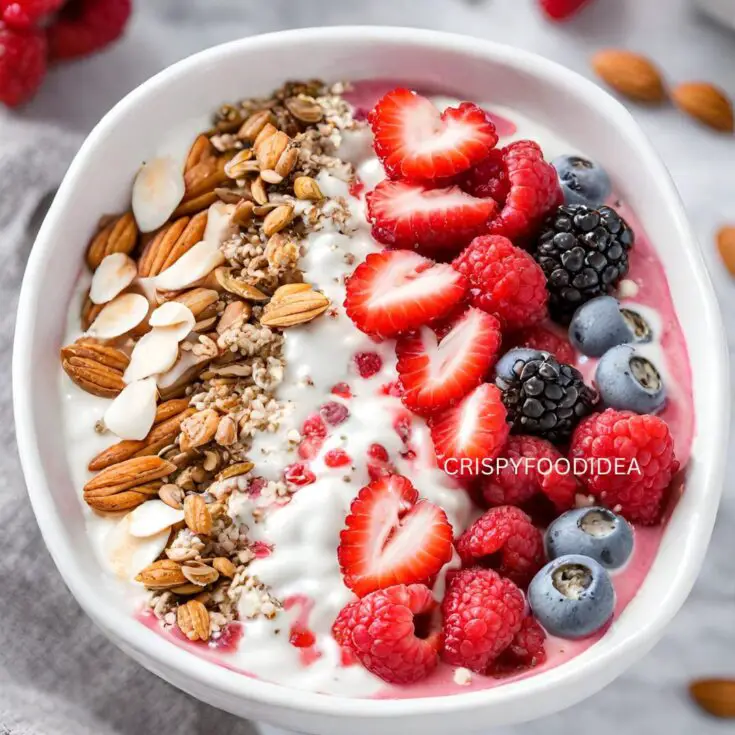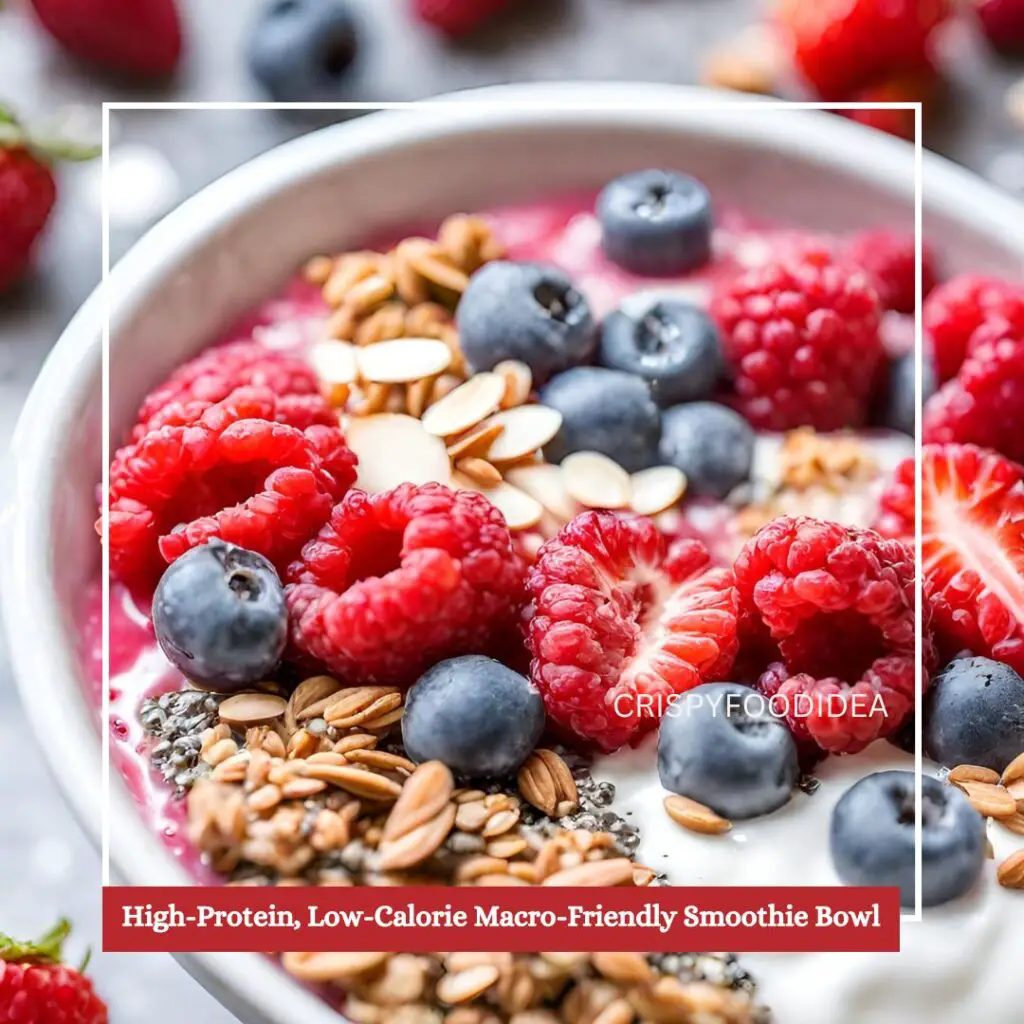In pursuit of a healthy lifestyle, it can be difficult to find nutritious and satisfying foods that match our dietary goals. Today, we’re going to dive into the world of macro-friendly high-protein, low-calorie smoothie bowls—a great addition to your arsenal of balanced recipes. These delicious bowls not only delight your taste buds, but they also pack a powerful nutritional punch by combining the power of protein with the simplicity of low-calorie ingredients.
In this article, we’ll dive into the benefits of adding high-protein and low-calorie foods to your diet, explain the nutritional goodness of each ingredient, and walk you through the process of creating a delicious smoothie bowl that will not only satisfy your thirst but also support your health and fitness goals. So if you’re ready to take your breakfast/snack game to the next level with a delicious combination of flavor and nutrition, let’s dive into the secrets behind creating the perfect macro-friendly smoothie bowl.
Related: Macro-Friendly Meal Prep Recipes
The Benefits of High-Protein, Low-Calorie Smoothie Bowls
- Protein’s Role in Muscle Building and Satiety: Protein plays an important role in muscle growth and muscle repair, which is why it’s a must-have for anyone or those who want to keep their body lean. A smoothie bowl high in protein, such as yogurt or almond milk, has a significant amino acid profile that supports these important functions. Protein also helps you feel fuller, which helps you control your appetite and limit your calorie intake Eating a smoothie with protein in it can help you feel fuller, making it a great option if you’re trying to manage your weight without sacrificing nutrition.
- Advantages of Low-Calorie Ingredients: Raspberries and strawberries are low-calorie foods that are packed with nutrients like vitamins, minerals, and antioxidants without adding too many calories to your smoothie bowl. If you’re looking for low-calorie smoothie recipes that are also good for your weight, you’ve come to the right place. This is a great strategy for weight management because it allows you to eat more food without eating too many calories. This means you’ll have a smoothie bowl that’s not only delicious but packed with all the nutrients you need to stay healthy.
- Macro-Friendly Recipes for Balanced Nutrition: Smoothie bowls are a great way to balance your macronutrients. By adding high-quality protein to low-calorie fruits, you’re creating a balanced meal that matches your macros. These smoothie bowls are macro-friendly, so you’ll be able to enjoy a delicious, satisfying meal on the go. Within your macro range, promoting a sustainable and fun approach to nutrition.
Related: Low-Calorie Dinner Recipes
Step-by-step guide for Recipe Preparation
- Start by adding 1 cup of frozen raspberries and 1/2 cup of frozen strawberries to your blender. These berries not only bring natural sweetness but also pack smoothie bowls with antioxidants, vitamins, and fiber.
- Using frozen berries not only enhances the texture of the smoothie bowl but also eliminates the need for ice, ensuring a thicker and more satisfying consistency.
- Pour in 100ml of unsweetened almond milk. It not only contributes a delicious creaminess to the mix but also keeps the calories low. Almond milk is a nutritious dairy alternative, rich in vitamin E and low in calories, making it an ideal base for a guilt-free smoothie bowl.
- Add 2 tablespoons of fat-free, unsweetened yogurt to the mixture. This ingredient not only increases the protein content but also adds a delightful tanginess to the smoothie bowl. Yogurt is a great source of probiotics, promoting gut health without compromising the macro-friendly aspect.
- Choosing fat-free, unsweetened yogurt ensures a high-protein addition without unnecessary sugars or fat, perfectly aligning with the goal of creating a nutritious and macro-friendly smoothie bowl.
- With all the ingredients in a blender, blend until smooth and creamy. Make sure that the mixture acquires a homogeneous texture, free from lumps.
- Adjust consistency by adding more almond milk if necessary. The goal is to create a thick, spoonable smoothie bowl that can be enjoyed with toppings while maintaining its macro-friendly profile.
- Pour the smoothie mix into a bowl and get creative with the toppings. Consider adding chopped fruit, nuts, seeds, or a drizzle of nut butter to increase texture, flavor, and nutritional value.
- Enjoy the delicious taste of this high-protein, low-calorie smoothie bowl that not only satisfies your taste buds but also contributes to your overall well-being.
Related: Weight Watchers Smoothie Recipes
Topping Ideas
Creative Topping Ideas
- Sprinkle on a handful of your favorite granola for a delightful crunch that contrasts with the smooth texture of the smoothie bowl.
- Boost the nutritional profile with a spoonful of chia seeds, adding omega-3 fatty acids and texture.
- Add a tropical flair by sprinkling lightly toasted coconut flakes for a hint of sweetness.
- For a chocolate twist without added sugar, include cacao nibs for a satisfying and antioxidant-rich topping.
Protein-Packed Toppings
- Enhance the nutty flavor of the bowl and up the protein content with a handful of chopped nuts.
- Top with a spoonful of fat-free, unsweetened Greek yogurt to up the cream and protein.
- Sprinkle in nutrient-dense flax seeds for an extra protein kick with a light, nutty flavor.
Related: Meals Under 200 Calories
Serving Size Recommendations
- Balanced Macros: Adjust serving sizes to meet your specific macronutrient goals, adjusting fruit, yogurt, and milk amounts accordingly.
- Ideal portion: A typical serving may contain 1 to 1.5 cups, but feel free to adjust based on your energy needs and dietary preferences.
- Personalization: Experiment with toppings and adjust amounts for individual flavor preferences while staying within dietary goals.
Related: Low-Calorie Snacks
High-Protein, Low-Calorie Macro-Friendly Smoothie Bowl Recipe

Boost your morning or breakfast with a smoothie bowl packed with high-quality, high-protein ingredients that are low in calories and high in protein. This smoothie is loaded with frozen berries, strawberries, and almond milk, as well as unsweetened, fat-free yogurt. Add crunchy toppings or nutrient-packed seeds to support your health and wellness goals. This guilt-free treat is as good for your taste buds as it is for your body.
Ingredients
- 1 cup Raspberries, frozen
- 1/2 cup Strawberries, frozen
- 100 ml Almond milk, unsweetened
- 2 tbsp Yogurt, fat-free, unsweetened
Instructions
- Blend fruit: Combine frozen raspberries and strawberries in a blender.
- Add almond milk: Pour in unsweetened almond milk for a creamy consistency.
- Include yogurt: Add fat-free, unsweetened yogurt to the mix for an extra boost of protein.
- Blend until smooth: Blend all ingredients until smooth, adjusting consistency by adding more almond milk if needed.
- Pour and Garnish: Pour the smoothie into a bowl and get creative with the toppings. Consider alternatives like granola, chia seeds, almond flakes, or a drizzle of Greek yogurt.
- Enjoy: Enjoy a satisfying, high-protein, low-calorie smoothie bowl that not only nourishes your body but also excites your taste buds.
Notes
- Experiment with different fruits or a protein powder of your choice to tailor the recipe to your preferences.
- Adjust the sweetness by adding a teaspoon of honey or maple syrup if desired.
Nutrition Information:
Yield:
1Serving Size:
1Amount Per Serving: Calories: 131Total Fat: 3gSaturated Fat: 0gTrans Fat: 0gUnsaturated Fat: 2gCholesterol: 2mgSodium: 102mgCarbohydrates: 26gFiber: 10gSugar: 12gProtein: 4g
Related: High Protein Meal Prep Recipes
FAQ
Q: Can I use different fruits in this smoothie bowl?
A: The recipe is versatile. You can experiment with different fruits, but be aware of the effect on overall calorie and protein content.
Q: Are there alternatives to almond milk for people with allergies?
A: Yes, you can substitute almond milk with other unsweetened plant-based alternatives such as soy milk, coconut milk, or oat milk, based on your preferences and dietary restrictions.
Q: How do I adjust the recipe for more protein without increasing the calories?
A: Increase the protein intake by adding a scoop of your favorite protein powder or adding additional protein-rich toppings like Greek yogurt, flax seeds, or extra nuts.
Q: What are the best toppings for those focused on losing weight?
A: Choose toppings that are low in calories but still add texture and flavor, such as chia seeds, chopped nuts, or a moderate amount of granola.
Q: How can I make a smoothie bowl more filling for a post-workout meal?
A: Increase the serving size and consider adding more protein-packed toppings or combine the smoothie bowl with a small portion of a high-protein snack for a well-rounded post-workout meal.
Q: Can I make this smoothie bowl if I am lactose intolerant?
A: Yes, you can choose a lactose-free yogurt option or plant-based yogurt to make the smoothie bowl suitable for people with lactose intolerance.
Q: Is this smoothie bowl suitable for a vegan diet?
A: Yes, you can make this recipe vegetarian by using plant-based yogurt and choosing a plant-based protein source if desired.
Suggested: Making of Enchilada
Living a high protein low calorie lifestyle doesn’t mean you have to compromise on taste or satisfaction A macro-healthy smoothie bowl can help you align with your health and fitness goals. The bowl is easy to adapt to your specific dietary needs.
Whether you want to build muscle, control weight, or enjoy guilt-free pleasure, this smoothie bowl is the perfect solution for you. You can add your favorite toppings like granola and chia seeds or opt for protein-packed nuts. Feel free to experiment with toppings of your choice. Adjust serving sizes to make sure you’re getting the nutrients you need. Nourishing your body with delicious, healthy foods is fun.
Related: Crockpot Soup Recipes
If you like this article about the high protein low calorie smoothie bowl recipe, please share it with your friends on Facebook, WhatsApp, Instagram, and also on Pinterest. Also, don’t forget to subscribe to this blog to get all the latest articles first on your mobile.

